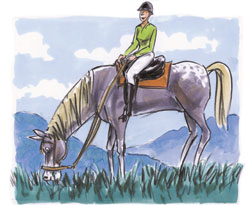|
is light and sensitive and trained to a hackamore, a bosal can be used very handily."

The bosal should
be placed in the spot where the nasal bone ends and the cartilage begins,
easily felt by running your hand down your horse's nose. The heel knot
should hang away from the chin. Bosals are available in rawhide and cable.
Although the cable may be cheaper, the rawhide can change to fit the shape
of your horse's nose better.
Many endurance and
pleasure riders are using rope halter hackamores which have knots placed
in exactly the right place to contact the sensitive spots on the horse's
face. "These work just fine when used with touch-and-release riding,"
says the Cortland, N.Y., instructor.
Another choice is
the side-pull hackamore, which is a rope and leather noseband that has
rings for reins on the side. "This is useful for starting colts,
because it's very easy to turn their heads left or right. When you pull
back, the noseband and chin strap tighten up just a little. It's also
useful if you have a horse that has not had hackamore training,"
Harris says. "The English-jumping hackamore is a similar bridle.
It looks a lot like an English bridle, except that it has no bit."
Side pull bridles
should be slightly above the cartilage spot; definitely not below, Harris
explains. "If you put a hackamore on too low, it will irritate, and
the horse will toss its head about."
Both the bosal and
the side-pull are good for beginning riders, or fill the bill if the horse
has had mouth problems and can't use a bit for a while. "But you
still need to ride them with a light touch," Harris stresses. The
mechanical, or leverage hackamore is another bitless device. It puts pressure
on the nose and under the chin. Generally it has a noseband, curb strap,
and a ring for the bridle and shanks.
"Keep in mind
that the mechanical hackamore acts somewhat like a curb bit," says
Harris, who adds that a noseband that is thick, soft and flat will be
more comfortable and easier on your horse.
The mechanical hackamore
should be placed higher on the face than a bosal, between the cartilage
spot and where an English noseband would rest.
"When you pull
back with a mechanical hackamore, the curb strap should be adjusted so
the shanks rotate 45 degrees. A good rule of thumb is you should be able
to put two fingers between the chin strap and the chin," the instructor
says.
The worst hackamore
currently available is one that encircles the horse's entire nose with
metal.
"The manufacturers
promote these as 'easy stop,' but they certainly aren't easy on the horse.
They're extremely severe, and should be avoided," she cautions.
Harris strongly advises
that before you just "slap on a hackamore, make sure your horse is
used to it. It's important to do some groundwork and make sure the animal
knows how to give its head. I'd advise first walking beside the horse
to make sure it understands, then first trying the bridle in a round pen
or small, safe enclosure."
Generally, endurance
riders like the hackamore because the horse can easily eat and drink with
the bridle on. Speed-event participants like it because it gives the horse
a free head. It's also a good alternative for horses with sensitive mouths.
"If you're a
pleasure rider and your horse is happy and works well with a hackamore,
there's no need to use anything else," Harris concludes.

|